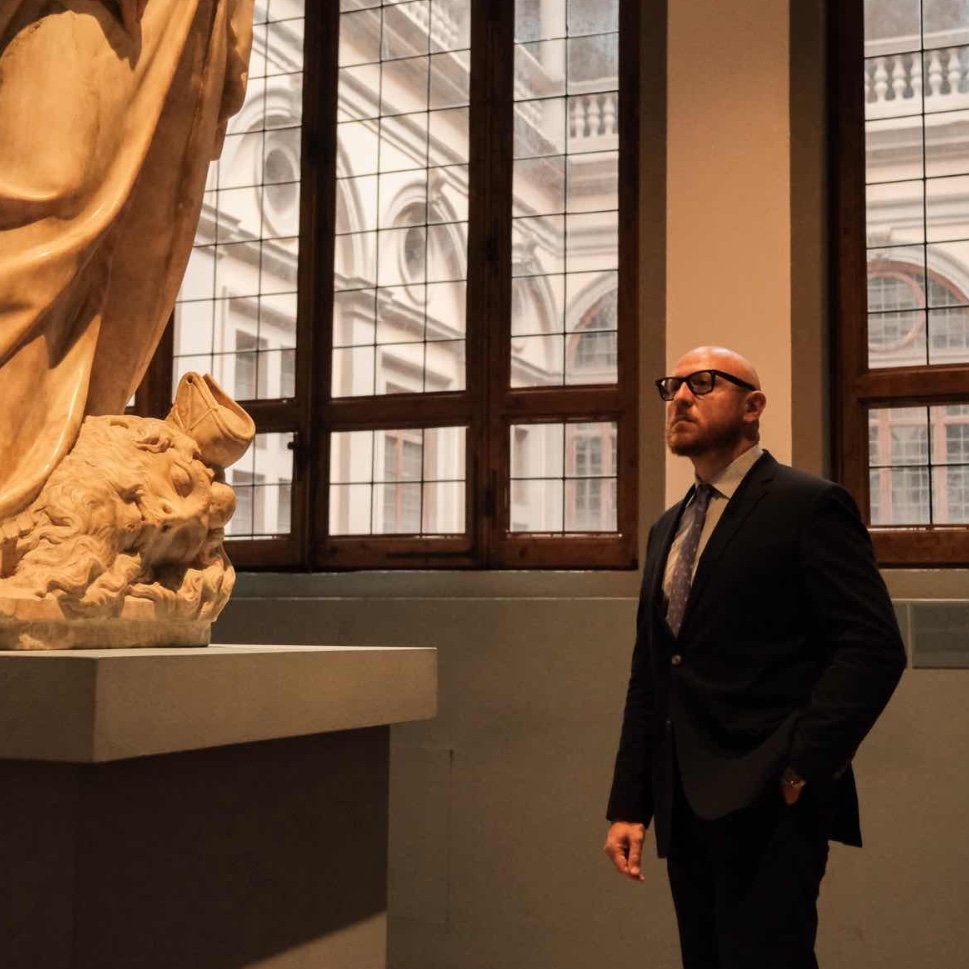
Tang Keyang
Tang Keyang is a curator and architectural designer based in both New York and Beijing. His studio is committed to making a unique blend of art and architectural designs that is multidisciplinary by its methodology and visionary by its goal.
Tang’s featured shows include Chinese Gardens for Living (at the German State Art Collection on behalf of National Art Museum of China) and The Paramount: A Collective Portrait of Contemporary Asian Arts (at the 2009 Boao Asian forum). He has been the curator of the Chinese Pavilion at the 12th Venice Architectural Biennale. The Glory of Classical Chinese Writing, one of his recent shows featured more than one hundred historical objects related to Chinese writing, this was exhibited at the Palace Museum from September-October 2010. Different from his peers, Tang not only designs the “software” part of his show but often makes the “hardware” for his projects. His curatorial approach is unmistakably contextual, boundary-crossing and architectural in an intrinsic sense.

Tang Keyang's Studio 02

Tang Keyang's Studio 01
As a dedicated educator and design critic, Tang has been involved in many pedagogic events for a number of Chinese and Western schools as well as institutions. He has been selected as the featured artist for New York City’s contemporary Asian art week and was among the first group of delegates to attend the Asia Society’s Young Leader Summits in Seoul. In 2009-2010, he served as the deputy director at Peking University’s Center for Visual Studies. Starting in September 2010, Tang also became a senior consultant to the National Art Museum of China and has remained as an active member on its advisory board.
Tang has written extensively on Chinese art and architecture for a wide variety of periodicals and catalogues. His recent publication includes A Garden Rising from Ruins and Delirious New York (author-designated translation). In addition to his scholastic works, Tang’s creative writings have been translated and published in several European languages.
Tang received his Doctor of Design in Architecture from Harvard University and his Master Degress in art history/comparative literature from the University of Chicago and Peking University.

Tang Keyang's Studio 03

Tang Keyang's Studio 04
1. How did you start making art?
I grew up in an intellectual family that was very close but not smothering and was integral to the art world. Meanwhile, having lived among the general population in the age before the market boom and witnessed their desires, ambitions and personal disasters, I have had a life that is intense enough for telling a vivid story.
Initially, I made art only as to complement “major” things more closely related to my professional interests – my literary writings, architectural research, curatorial projects, and so on – but I soon found they could stand alone as a different kind of story. My works may be appropriately categorized as “visionary” but cannot be completely separated from the “necessary”: on one side there is my curiosity in whatever is intellectually stimulating, and on the other is my instinct based on real life experiences.
2. Briefly describe your works from the perspective of what it could tell us about you?
My art, including those architectural/architectonic designs, are what they call “art in general,” where the concept and boundaries of “work” are intentionally kept ambivalent. To put this in another way, my works pay less attention to media, subject or “authorship” and more to the larger context where they are created. This involves an exploration of the artist/curator/designer that overlaps – the act of sifting through a scholar’s mindset for vivid stories, or examining an exhaustive list of things for a personal history that emerges out of liing in this world.
I do not mind being called a scholar, a curator, a novelist or an artist, yet I do wish to be consistent in addressing artistic, architectural or urban issues as a whole. For my artistic pursuits I prefer to be a “Renaissance Man” rather than a specialist.

Illumination from Collections and Civilizations--Special Exhibition Held at the Forbidden City, Beijing, which is desiged and curated by Tang Keyang. Courtesy Tang's Studio

Painted Mountain Plan desigend and curated by Tang Keyang; Courtesy Tang's Studio
3. What experiences have most influenced your choice of subject matter, medium and style?
As mentioned above, I have lived as a normal person in society. Such a life can never be furnished with a thin veneer, nor need it be too “avant-garde.” As Chinese people always believe, there is a more “natural” attitude towards artistic creation as long as you can maintain an appropriate balance between the articulated and the “chanced-upon.” For the above reasons the (Chinese) “garden” becomes an important framing concept for all of my art.
My professional training renders more affinity to space-making alongbwith embracing a Constructivist appearance in my work but my designs are also tangible, detailed and story-telling. My world-making strategies grew out of simultaneous sociological concerns and aesthetic ideals. They imply not only collaged images, but a softer and more idiosyncratic approach to the generic enormity of the built environment.
4. Is your formal or informal training as an artist/designer useful? How?
Unlike people commencing their education at the age of eighteen, I went to architectural schools quite late. I learned essential art skills and important life concepts from all possible sources: my grandparents and parents, artist neighbors and friends, but little from the professional training. In fact I have found that this is very useful because it taught me why to make art as well as how to construct it.

One of Tang's Publications-From Ruined Gardens to Yan Yuan

Chinese Gardens for Living Curated by Tang Keyang; Courtesy Tang's Studio
5. Does your work reflect issues in yourself, in society or community? What would you say is the purpose for making art?
Yes, and it has to. We cannot imagine other reasons why we would need such a thing called Art. Though it also needs to do so strategically. With reference to two popular myths about “creativity” and about “societal merits,” I want to argue that art should get neither too close to nor too far from social ideals. For example, I made a series of visionary architectural drawings, wrapped up by a fabricated medieval tale, to illustrate my reflection on the current Chinese urbanist discussion. The story needs be novel enough to refresh people’s thoughts and distant enough from them to create various cultural and professional clichés. Meanwhile, it still needs to be appropriately supported by arguments and premises that are generally accepted by most scholars in their related field.
6. Do you appreciate culturally specific works of art? If so how does your personal and cultural background show up in your work?
In my opinion, it is healthy not to be too self-conscious about your cultural identity. As an artist and author living in New York City for most of the year, I cannot be blind to what happens under my nose.
In addition to my New York research, for example, I have had my own visionary reinterpretation/intervention of Battery Park City (ie.a city hooligan’s unexpected visit to the banker’s backyard, which is against the initial wishes of the planner). The topic about two contested views of urban environment is simply becoming universal, immediate and not bound to one’s cultural background.
On the other hand, you need be persistent with your own approach and perspective. I recently translated Rem Koolhaas’ Delirious New York into Chinese and I particularly like his idea of “retrospective manifesto”: as a cultural outsider one may help your theoretical perfection of the ready-made reality. The only condition is that you cannot be both onshore and drifting away.

Tang Keyang's Studio 08
7. Is there anything you would like to say about your local art scene or the international art market, art education, and/or system for art exhibition?
So far, I am a beneficiary of such a system, not it's victim, so I am probably not in a good position to make very objective or critical comments. In general, I think that contemporary art should open it's door to a wider variety of audiences. As my New York photography series suggests, our visual culture now presents a kind of peculiar “translucency” that is optically intriguing as well as politically uncertain. The openness that it reveals is somehow still an illusion. The in-between status is aesthetically interesting, but there also lurks a danger that it leads to nowhere.
8. How does your current portfolio fit into the rest of your body of work?
They are highly correlated though they may look very different. As stated, my works can be summarized as a variety of different representations of “gardens.” As a subject matter, the “garden” first of all embodies an interdisciplinary, trans-scale approach, as opposed to a simple division of the physical reality into human construct versus regional operation.
Despite the popular impression that a garden might satisfy only trivial horticultural interests, as an artistic notion the “garden” introduces a phenomenological view of the built environment that is especially meaningful in our rapidly urbanized world. To design a “garden” necessitates a synthesis of numerous things: not only structure but also infrastructure; not only schemes and ideas, but also materials and textures; not only static composition but also an eidetic memory; not only a top-down concept but also a bottom-up process of implementation.
To perceive such a “garden” will require a flexible and liminal perspective, in which solid, triumphant spaces are often collapsed into indefinite and intimate experiences. Altogether my works form a complete typology of “garden space” as embodied in today’s architectural practices as well as in its general mentality.




























